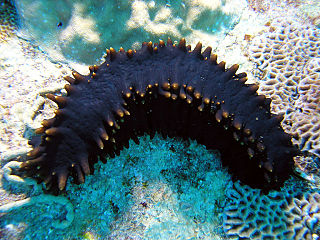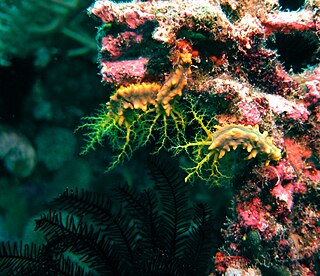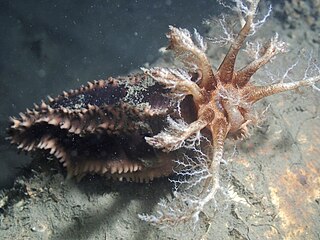
Sea apple is the common name for the colorful and somewhat round sea cucumbers of the genus Pseudocolochirus, found in Indo-Pacific waters. Sea apples are filter feeders with tentacles, ovate bodies, and tube-like feet. As with many other holothurians, they can release their internal organs or a toxin into the water when stressed.

Holothuriida is an order of sea cucumbers. Taxa within the order Holothuriida were previously classified in the order Aspidochirotida, which was determined to be polyphyletic in 2017. Some taxa were also reclassified into the clades Synallactida and Persiculida.

The orange-footed sea cucumber is the largest sea cucumber in New England, United States. It is one of the most abundant and widespread species of holothurians within the North Atlantic Ocean and the Barents Sea (Russia), being most abundant along the eastern coast of North America.

Cucumaria miniata is a species of sea cucumber. It is commonly known as the orange sea cucumber or red sea cucumber due to its striking color. This northeast Pacific species is often found wedged in between rocks or crevices at the coast or on docks and can generally be identified by its orange bushy tentacles protruding above the substrate.

Psychropotes longicauda is a species of sea cucumber in the family Psychropotidae. It inhabits the deep sea where the adult is found on the seabed. The larva is pelagic and has an appendage shaped like a sail on its back which may enable it to move through the water.

Stichopus chloronotus is a species of sea cucumber. Common names include the greenfish sea cucumber, the spiky sea cucumber and the black knobby sea cucumber. It is native to the Indo-Pacific region. It has a wide range and is abundant and the IUCN lists it as being of "Least Concern".

Cucumariidae is a family of sea cucumbers, marine animals with elongated bodies, leathery skins and tentacles that are found on the sea bed.

Bohadschia argus, the leopard sea cucumber, leopardfish, or tigerfish, is a species of sea cucumber in the family Holothuriidae. It is native to the tropical Western Indo-Pacific region.

Colochirus quadrangularis, commonly known as the thorny sea cucumber, is a species of sea cucumber in the family Cucumariidae. It is found in shallow seas in tropical parts of the Indo-Pacific region.

Pearsonothuria is a genus of sea cucumbers in the family Holothuriidae. Pearsonothuria graeffei is the only species in the genus. Graeffe's sea cucumber is found in the tropical Indo-Pacific Ocean and the type locality is Viti Island, Fiji. It is named after Eduard Heinrich Graeffe, Semper's coworker at the Museum Godeffroy.

Ocnus is a genus of sea cucumbers in the family Cucumariidae.

Psolus phantapus, also known as the brown psolus, is a species of sea cucumber in the family Psolidae.
Psolus chitonoides, also known as the slipper sea cucumber, armoured sea cucumber, creeping armoured sea cucumber, or creeping pedal sea cucumber, is a species of sea cucumber in the family Psolidae. It is found in shallow water on the western coast of North America. The scientific name "chitonoides" means resembling a chiton.

Synaptula recta, sometimes known as the gut-like sea cucumber, is a species of sea cucumber in the family Synaptidae in the phylum Echinodermata. It occurs in shallow water in the tropical Indo-Pacific region.

Pawsonia saxicola, the sea gherkin, is a species of sea cucumber in the family Cucumariidae. It is found in the northeastern Atlantic Ocean and the Mediterranean Sea.

Thyone fusus is a species of sea cucumber in the family Phyllophoridae. It is found on the seabed in the northeastern Atlantic Ocean and the Mediterranean Sea. It is a suspension feeder and catches food particles floating past with its branching feeding tentacles.

Paraleptopentacta elongata is a species of sea cucumber in the family Cucumariidae. It is found in the northeastern Atlantic Ocean and parts of the Mediterranean Sea. It is an infaunal species, occupying a burrow in the seabed, from which its anterior and posterior ends project.

Thyone roscovita is a species of sea cucumber in the family Phyllophoridae. It is found on gravel, sand and mud substrates in the north-eastern Atlantic Ocean and the Mediterranean Sea at depths down to about 40 m (130 ft). It is a suspension feeder and catches food particles floating past with its branched feeding tentacles.
Leptosynapta bergensis is a species of sea cucumber of the family Synaptidae.
















